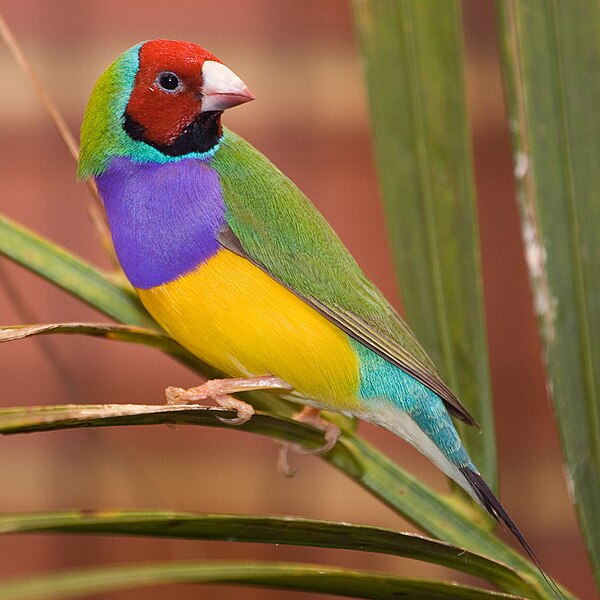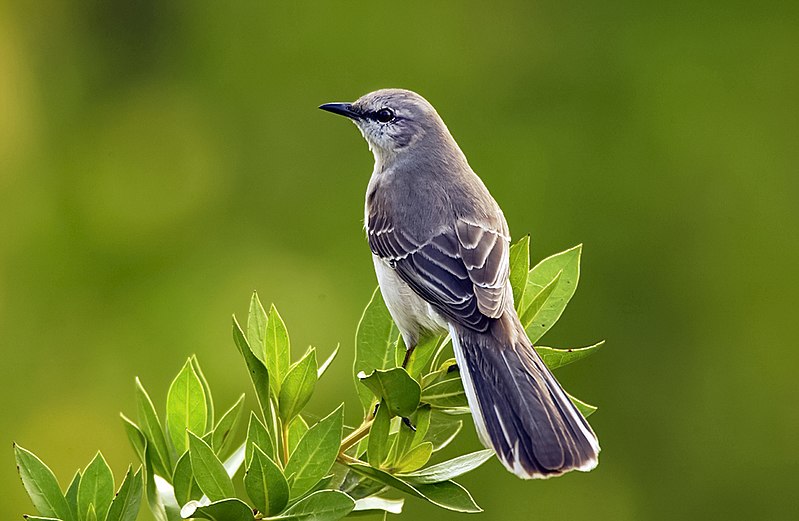The Gouldian finch (Erythrura gouldiae) is at once a popular pet and an endangered species. Large and stocky (for a finch), it boasts a stunning array of 7 bright colors, a fact that has long rendered it among the most expensive of all finches. However, it is now widely bred here in the USA, and prices are coming down a bit.
Color and Male Dominance
 In addition to thrilling bird owners for the past 100 years or so, it seems that the males’ spectacular plumage plays an unexpected role in Gouldian finch behavior as well. Wild Gouldian finches are unique in possessing heads that may be red, black or yellow in color. Red-headed males dominate all others, with yellow headed males being at the bottom of the pecking order.
In addition to thrilling bird owners for the past 100 years or so, it seems that the males’ spectacular plumage plays an unexpected role in Gouldian finch behavior as well. Wild Gouldian finches are unique in possessing heads that may be red, black or yellow in color. Red-headed males dominate all others, with yellow headed males being at the bottom of the pecking order.
Mixing Things Up
To discover if head color granted any specific survival advantage, University of New South Wales researchers applied black dye to yellow-headed males. Although the behavior of the dyed birds did not change, other individuals avoided fights with these formerly bullied males.
When red-headed males were dyed yellow, the former red-heads remained aggressive, but other birds did not readily give way to them at feeding stations (it might be interesting to show the redheads a mirror – maybe they would “realize” they were no longer dominant!).
So it seems that red-headed males truly are more aggressive than others, and that a red head likely confers competitive advantages in activities such as feeding and access to favorable nest sites. Future research will focus on the connection between color and behavior in other species.
Gouldian Finches in the Wild
In the wild, Gouldian finches are limited to small sections of wooded savannah in Australia’s tropical north, and are considered highly endangered.
They live in small groups both in and out of the breeding season and are, as finches go, rather specialized in their feeding habits. Gouldian finches vary their diets with the seasons. For much of the year, sorghum seeds (a grass) are their primary food, but during the rainy season they subsist nearly entirely upon moths, grasshoppers, termites, spiders and other invertebrates.
Next time I’ll go over some special concerns to bear in mind when considering a pair of these lovely birds.
Further Reading
World Wildlife Fund Australia has posted an interesting article on the dire threats facing Gouldian finches in the wild: http://www.wwf.org.au/articles/feature17/
Gouldian finches make wonderful pets and aviary birds, but require more room than similarly-sized finches. Please see my article Bird Cage Overview for further information.
Image referenced from Wikipedia and originally posted by Martybugs.
 That Bird Blog – Bird Care and History for Pet Birds
That Bird Blog – Bird Care and History for Pet Birds

 To test the birds’ abilities, researchers gently touched mockingbird nests on 4 successive days, and then walked quickly away. By the third day, the resident mockingbirds would leave the nest upon sighting the researcher approach, even if the person dressed differently and used an alternate route to the nest. The enraged birds often attacked the intruders with pecks to the head before they could reach the nest.
To test the birds’ abilities, researchers gently touched mockingbird nests on 4 successive days, and then walked quickly away. By the third day, the resident mockingbirds would leave the nest upon sighting the researcher approach, even if the person dressed differently and used an alternate route to the nest. The enraged birds often attacked the intruders with pecks to the head before they could reach the nest. Ecuador’s yellow-eared parrot (Ognorhynchus icterotis) and golden-plumed parakeet (Leptosittacia branickii) face a most unusual threat – an annual religious celebration. The group Aves and Conservation has identified the collection of palm fronds for Catholic Easter celebrations as the main cause of the species’ near disappearance from Ecuador.
Ecuador’s yellow-eared parrot (Ognorhynchus icterotis) and golden-plumed parakeet (Leptosittacia branickii) face a most unusual threat – an annual religious celebration. The group Aves and Conservation has identified the collection of palm fronds for Catholic Easter celebrations as the main cause of the species’ near disappearance from Ecuador. You can read about recent golden-plumed parakeet nesting records at
You can read about recent golden-plumed parakeet nesting records at  Research conducted at New York’s Cold Spring Harbor Laboratory (Nature: May, 2009) has, for the first time, illustrated the complex interplay of genetics, learning and social situation in the acquisition of birdsong.
Research conducted at New York’s Cold Spring Harbor Laboratory (Nature: May, 2009) has, for the first time, illustrated the complex interplay of genetics, learning and social situation in the acquisition of birdsong. Ornithologists are interested in discovering if the same process is at work in other species as well…perhaps even the complex and beautiful song of the nightingale is encoded in each male chick.
Ornithologists are interested in discovering if the same process is at work in other species as well…perhaps even the complex and beautiful song of the nightingale is encoded in each male chick.